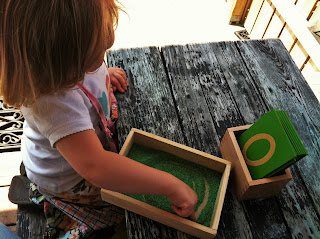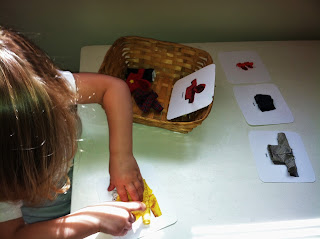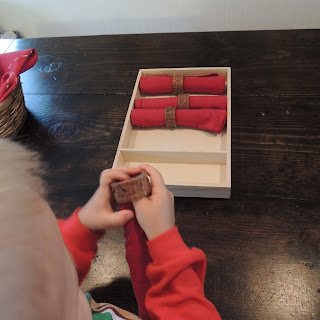The materials shown here are placed in areas where the children can reach and work on them when they want. They usually work on these during our morning work period, but they have been known to work on nights and weekends, too.
My son has been exploring the teens board (when he feels necessary) for about 1 year. He has enjoyed doing this so much he has memorized these addition problems, and now knows how to figure them out by working on paper alone.
His work at 3 yrs old using teens board and beads.
At 3 yrs, he learned the value of coins. Shortly before turning 4 we began working with money in place of beads:
We don't do much with the teens anymore, and I haven't purchased the tens board (so pricey). Instead, we use this board with the bottom 10 spot. We play a game called "beat the builder." I build a number (20, 30, 40, 50, 60, 70, 80 or 90). Let's say I made the number 20, then I choose a single number (1-9). We'll say number 5. I place 5 below 20. He writes the problem down on paper (20 + 5 = ) and attempts to solve the problem before I "build" it by adding the 5 to the board ( he always wins ;) This is followed by him cheering, usually a high five and calling out the next two numbers to add together.
Last week he said, "Let's add 90 and 9 ... let's make 99." I giggled to myself as he already solved it before we got the numbers out to play the game.
My daughter has shown a huge interest in numbers and counting since 18 months. At that time she was counting to 11 (skipping number 7). One morning she woke up counting in her bed, and continued counting anything she could find until well into the afternoon.
I'm no Montessori expert, but I do know that's a sign of a sensitive period. I was thankful to have been able to provide her with the materials she needed during this time.
She loves the sand tray and is writing the numbers 0 and 1.
The spindle box is something we enjoy doing together now that she is able to recognize numbers 0-9. It teaches her how to count one object at a time, allows her to see the written number and see a visual of that amount at the same time.
Every time she completes this work, she stands up and gives me a great big hug.
I'm not Montessori trained, not an expert and not a purist. Just a Mom following my children's interests at home until it's time to part for Kindergarten. And I hope that day takes its time getting here ...








































